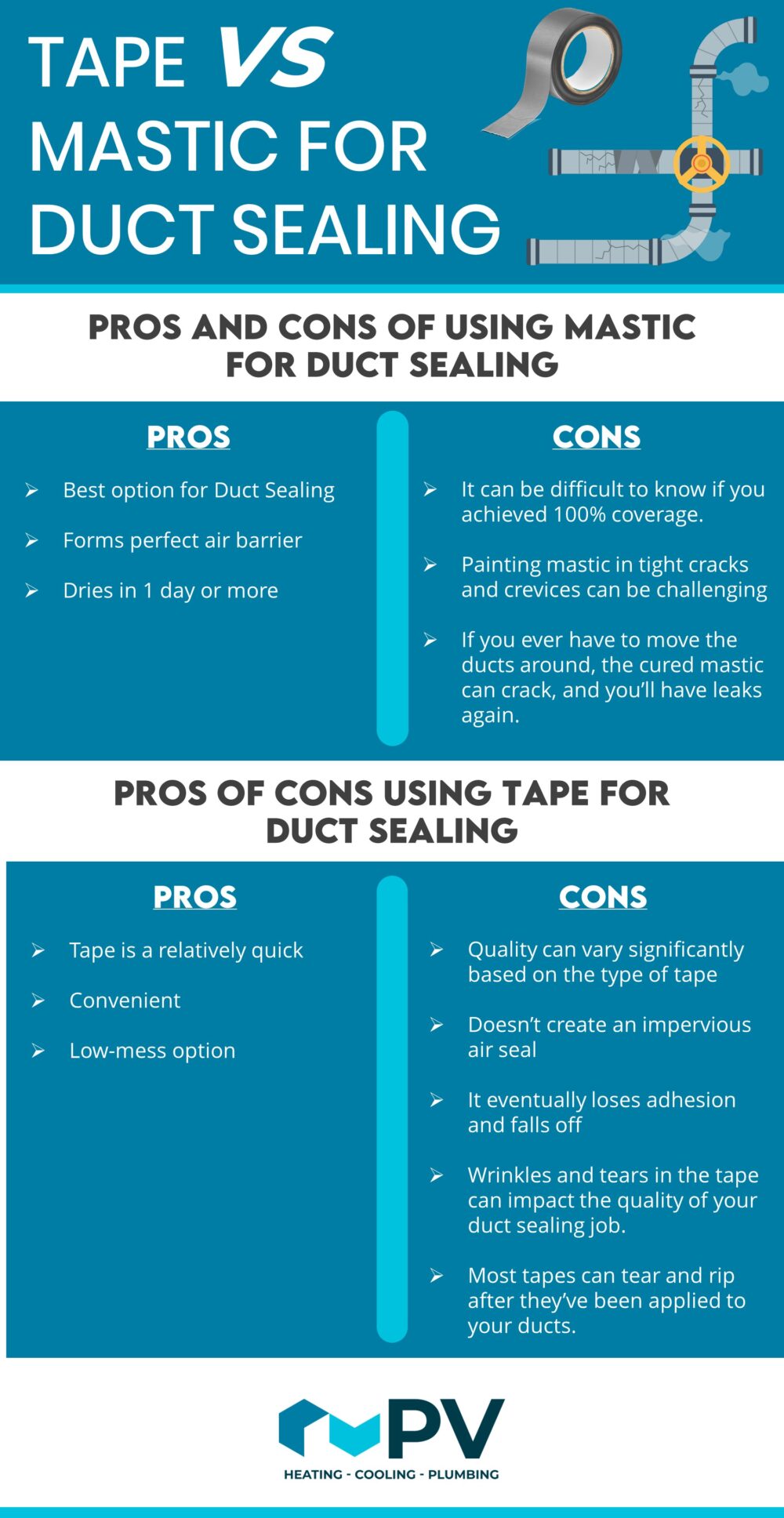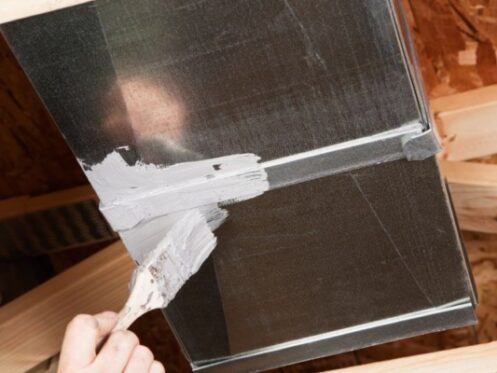If you’ve made it to this article, you likely already know why sealing your ducts is so important.
From reducing energy loss to improving indoor air quality, there are lots of good reasons to seal your leaky ducts. The question isn’t if you should seal them. It’s how. And to what extent?
In terms of duct sealing materials, there are two product categories you’re probably considering: tape and mastic. Each one has advantages and disadvantages, so let’s consider why you might use one, the other, or both.
After understanding how each product is best applied, you might reconsider whether duct sealing is a DIY project after all.
Pros and cons of mastic for duct sealing
When properly applied, mastic is your best option for duct sealing. After painting it onto all the leaky areas and filling in the gaps, mastic hardens and forms a perfect (if you did it right) air barrier. Depending on the conditions in the area where your ducts are located, it can take mastic a day or more to dry completely.
Unlike most tapes, mastic won’t deteriorate and lose its adhesion over time. It’s a permanent solution that lasts as long as your ductwork, so you can maximize the benefits of duct sealing!
Ok, that’s why mastic is good. Here’s why it sometimes isn’t so good:
- It can be difficult to know if you achieved 100% coverage. Just because it looks like you painted over a gap doesn’t mean you adequately sealed that gap.
- Painting mastic in tight cracks and crevices can be challenging; in some cases, it might even be impossible.
- If you ever have to move the ducts around, the cured mastic can crack, and you’ll have leaks again.
- When you’re trying to seal a really big gap, you might accidentally get globs of mastic inside the ducts themselves. If the mastic you’re using isn’t rated zero VOC, this could create an indoor air quality issue.
Mastic is messy.
For these reasons, most HVAC pros use a combination of mastic and tape for sealing ducts. Sometimes, it’s easy and effective to use mastic. Other times, mastic simply isn’t the best choice.
Pros and cons of tape for duct sealing

Sealing your ducts with tape is a relatively quick, convenient, and low-mess option. Certain kinds of tape are great options for duct sealing. Others… not so much.
Let’s start by mentioning the kind you definitely shouldn’t use duct tape. Despite its name, duct tape is a terrible choice for duct sealing! It doesn’t create an impervious air seal, and it eventually loses adhesion and falls off. Duct tape is good for lots of things; ducts, strangely enough, simply aren’t one of them.
Another option is silver foil tape. This is a better choice, but not the best. Some types of foil tape are readily available at hardware stores, but the quality varies quite a bit. And even the best performing types pales in comparison to the mac-daddy of duct sealing tapes: mastic tape.
Yes, mastic tape is both mastic and tape. Unlike “duct tape,” the name doesn’t lie.
Mastic tape looks like regular foil tape, but it’s a lot thicker. Unlike most foil tapes, mastic tape adheres to your ducts with actual mastic-grade adhesive material. You get the benefits of mastic with the convenience of foil tape!
In sum, the tape can be a good option for your ducts, but there are potential downsides:
- Quality varies: Some foil tapes adhere pretty well, but others lose their adhesion and quickly fail.
- Wrinkles and tears in the tape can impact the quality of your duct sealing job.
- Most duct sealing tapes eventually lose their adhesion and fall off. If they last as long as your ductwork lasts, that’s not a problem. But they might not.
- , Unlike bona fide mastic, most tapes can tear and rip after they’ve been applied to your ducts.
Is duct sealing a DIY project?
Now that you know the pros and cons of mastic and tape, you might be wondering if this is the kind of thing you should tackle yourself. While anyone is free to seal their ductwork any time they want, there are a few potential problems with DIY-ing this one.
The small problems are materials, time, and difficulty. First, you’ve got to get mastic and/or a good quality tape (preferably mastic tape, which isn’t so easy to come by). Then you’ve got to spend a lot of time maneuvering around ductwork in a dark, tight crawlspace or attic.
Oh, and if you’ve got hard pipe ducts with insulation wrapped around them, you’ll have to take all that insulation off, seal the leaks, and then put the insulation back. That is a big job!
But aside from these issues, there’s an even bigger hurdle: work quality.
We reduce duct leakage to 4% or less. It’s hard to do that, but we can measure our efforts until we hit that benchmark.
4% duct leakage is super minimal. Even the best, most thorough duct sealing job will struggle to reduce leakage by more than that.
And if you’re DIY-ing, you won’t have any idea whether you’ve hit that benchmark.
Whether we’re using mastic, mastic tape, or a combination of materials, we do the following to ensure we’ve reduced every home’s duct leakage to 4% or less:
- Duct blaster test: After initially sealing the obvious leaky areas, we perform this test. We send colored smoke through your ducts and observe where it comes out. The areas where it leaks out still need to be sealed, so we seal them and perform the test over again. Eventually, we stop seeing smoke.
- Measuring actual leakage: Using special equipment, we can calculate the actual percentage of air that’s leaking out of your ducts vs. air that’s properly distributed throughout your home. This is how we verify that you’re down to just 4% duct leakage.
In the end, you won’t have to wonder whether your ducts are well sealed. You’ll know they’re sealed tight with the best possible materials.
Ductwork is pretty complicated. There’s a lot to consider in addition to leaks.
In many cases, duct sealing comes secondary to other ductwork fixes. Homes throughout the Atlanta area have ductwork that’s undersized, damaged, or just poorly installed. Before sealing your ducts, you need to determine whether your existing ducts are worth sealing.
Otherwise, the tape vs. mastic question is pretty much irrelevant.
If you’re considering duct sealing to minimize energy loss and improve indoor air quality in your Atlanta home, give us a ring! We’ll analyze your ducts to determine the best possible solution, whether that’s sealing them with tape, painting on some mastic, or something else.

